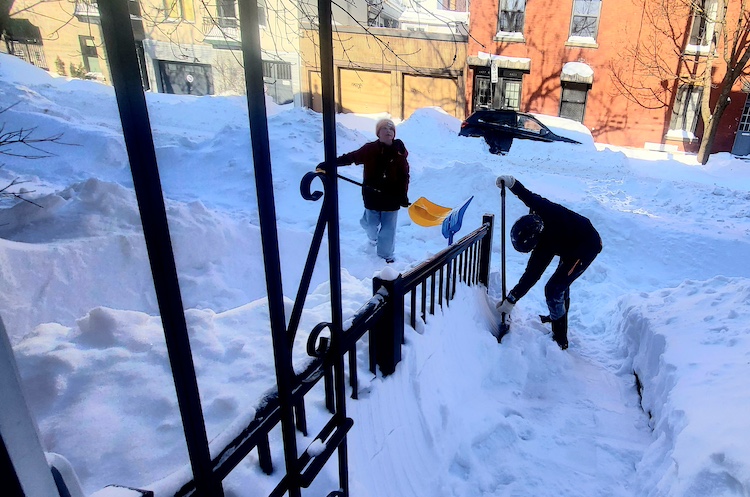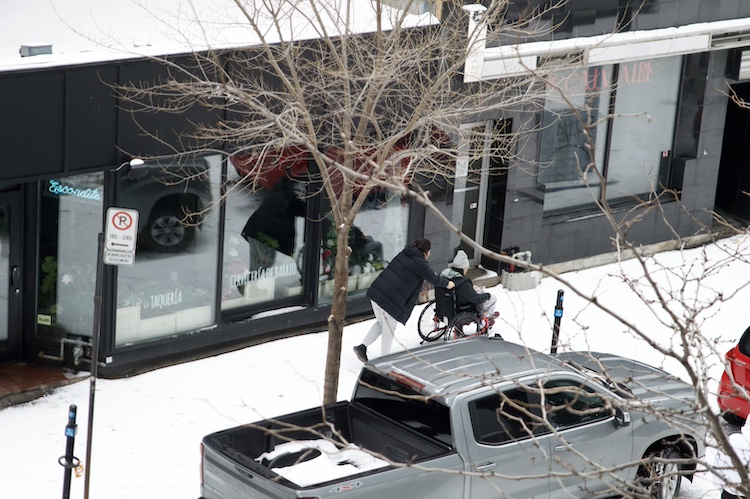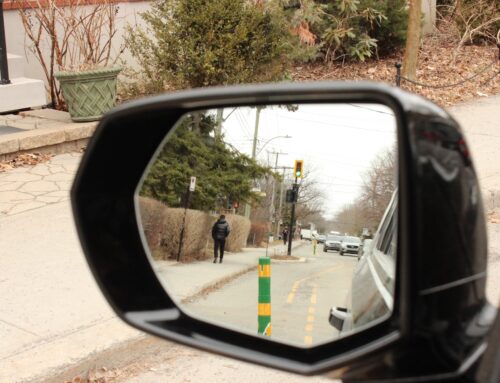BY Hannah Bell & Charlotte Weissler
“I got stranded for a good 10 days, perhaps 12,” says 78-year-old Guy Glorieux, a Montreal resident. “What could I do? I didn’t yell; I just took it as it was, but it was long.”
After a record-breaking storm in early 2025, Glorieux, who uses a walker, could not leave his home for nearly two weeks. Over 70 cm of snow fell in just four days, the most the city has seen since 1941.
“There was nothing I could do except watch movies, TV, read a book or work on my computer,” says Glorieux.
The snow began on February 14, but the snow clearing was not complete until March 3rd. Glorieux says even then, mobility was an issue.
“I saw people walking around the sidewalks, but I couldn’t access it with my walker. I don’t have very strong legs, so I need it to move around,” he says.

Two young boys shovel heaps of snow in front of Guy Glorieux’s home. Photo courtesy of Guy Glorieux.
Montreal media relations officer Hugo Bourgoin explains that the snow-clearing process is handled through three priority levels. First, major arteries, major commercial streets, priority bus routes and reserved lanes are cleared, with local streets and industrial sectors coming last. This system does not prioritize areas most often used by handicapped individuals.
Bourgoin emphasized the scale of a snow-clearing project like this after such a major weather event.
“More than 10,000 km of snow on streets and sidewalks had to be cleared, and approximately 3,000 people were involved,” said Bourgoin.
Due to labour laws, the clearing operations had to be paused for two days of mandatory break for workers. Bourgoin says this contributed to the project taking 17 days to complete.
“It is impossible for snow loading to be done at the same pace in all sectors of the city,” he notes.

Woman pushes her husband in a wheelchair through Montreal’s snowy, downtown sidewalks. Photo by Hannah Bell.
Glorieux is not the only one who faced significant obstacles after the snowfall. Statistics Canada recorded 523,600 people with disabilities in the city of Montreal, which is about 16 per cent of the population. Over half of Montreal’s disabled population is over the age of 55, making seniors the most vulnerable demographic.
Doreen Friedman is the recreation coordinator for Place Kensington, a senior home located in Westmount. She says residents faced the same trouble as Glorieux.
“Nobody went out. Even when the snow was cleared, people wouldn’t go out. It was still slushy and icy,” says Friedman, noting that a short journey from the front door of Place Kensington to a car was still too much. “It has to be really dry and clear everywhere for people to feel safe and secure.”
For some, the snow-clearing process only caused more issues. The plowing of roads resulted in massive snowbanks on driveways and sidewalks.
Nomathamsanqa Mpofu uses the paratransit service in Montreal, a reservation-only, door-to-door shuttle service run by the city.

Nomathamsanqa Mpofu’s wheelchair decorated with stickers and patches. Photo by Hannah Bell.
Mpofu uses a wheelchair, which can be difficult year-round, but the winter season significantly limits her options for transportation. Even paratransit, a service provided specifically to those with physical disabilities, was nearly unusable.
“When you get in front of your building, there’ll be a huge pile [of snow], and then the transport guy has to drive all the way down the road to find an opening for me to get through,” she explains. “I feel like they give us an opportunity to go to school, to work, to do what we need to do for ourselves, to be independent, to get out of the house.
Mpofu explains that it is generally reliable but “you learn after using the transport for a couple of years” to plan for the shuttle to run late and to give yourself extra time.”
A total of 1,245 complaints were lodged against the paratransit service between Oct. 2024 to Mar. 2025, the majority being about customer service and employees.

Chart showing the top complaints against Paratransit. Infographic by Hannah Bell.
In a 2022 study for the Journal of Transport & Health, about 5 per cent of the Quebec population was considered eligible for paratransit services. Yet in Montreal, only 1.7 per cent of people were STM paratransit users, or about a third of the eligible population.
Mpofu recounted an instance where she had to teach the driver that the bus could be lowered for wheelchair entry. “I don’t know if they get training on this stuff or not,” says Mpofu. This leaves the responsibility to fall on disabled individuals to teach and provide instruction.
Montreal’s vibrant cultural scene is becoming more accessible, but accessibility laws still prioritize physical impairments over cognitive disabilities. Through audio description and inclusive initiatives, venues are working to close the gap. Video by Charlotte Weissler.




